Questions and Answers – August 2010
Neil answers questions of the greatest general reader interest here, but they must be accompanied by a photo of the plant or problem. Here are this month’s questions and Neil’s answers.
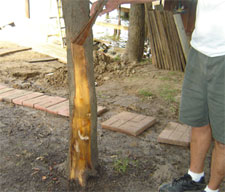
Question: My magnolia tree was recently damaged by workers putting in a retaining wall at my home. Is there anything I can do to help it heal? L.W., Cedar Creek Lake.
Answer: Use a utility knife to trim away the loose bark. Be careful not to peel it up the trunk any farther. New bark should begin to spread in from the sides of the wound. Hopefully, it may be re-covered within 2-3 years. If the exposed side faces to the west, and if the sun blazes onto it, you might consider paper tree wrap to protect against sunscald. But, if it were going to happen, it probably already would have done so. Just be patient, keep the moist, and hope for the best.
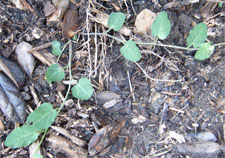
Question: We have quite a bit of this creeping weed in our flowerbeds, and we don’t know how to get rid of it. We have bermudagrass and hollies where it’s growing. M.G., Forney.
Answer: Any non-grassy weed can be eliminated with a broadleafed weedkiller (containing 2,4-d). You could certainly do that to eliminate weeds within bermuda turf. In the beds, weeds like this are probably more easily and reliably eliminated simply by consistent hoeing. It’s not hard work if the hoe is sharp and if the soil isn’t really wet. Putting a couple of inches of bark mulch down would help as well.

Question: What would the reason be for this unusual growth on my Knockout rose? After the spring bloom, I trimmed off the old flowers. These branches with all the thorns started growing very closely together. M., West Plano.
Answer: The focus is soft on the stems of the rose, but it looks like it could be fasciated growth (stems are flattened, dividing in one plane only). That would account for the great abnormality in the growth. It could also be growth from the rootstock (below the graft union), in other words, from another variety of rose altogether. In either event, you want to remove every bit of this odd growth, as it will overtake your Knockout’s growth.
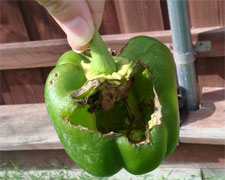
Question: We were getting a decent crop of peppers from our bell pepper plants, but the last month, something has been putting big holes in the peppers. We’ve seen no insects, and I’m afraid to use insecticides. (I’m pregnant.) We thought it might be birds, so we built a wire cage around the plants, but the holes continue. I’m throwing away one or two a day now. What can we do? D., no city given.
Answer: The way this looks, I’d almost guess that the surface of the pepper was sunscalded, and that the tissue deteriorated from that point on. Your cage would have kept birds away (nice cages!). Caterpillars are about the only other candidates, and I would have expected you to have seen either the caterpillars or evidence of their presence (droppings).
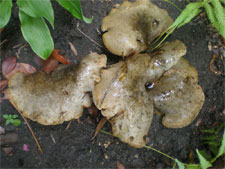
Question: These have appeared in my shade flowerbeds for the past two summers. Some have come up among hostas, ferns, ajuga and other plants. This one came up in bare ground. I take them out because they’re so ugly. What are they, and how can I discourage them from spreading? S.L., Dallas.
Answer: These are one of thousands of types of saphrophytic funguses, i.e., mushrooms. They are harmless. They live off decaying organic matter, and they soon run their course for the season. They recur because they leave spores behind. Applying sulfur to them would probably make them die, or you can remove them mechanically. I simply admire/tolerate them in my own garden, although I’d probably remove them if they were near a walk and if I had visitors coming.
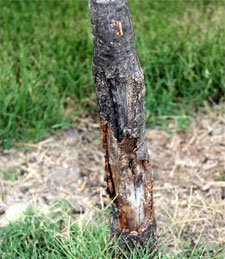
Question: We planted this red oak tree last year. Several months ago, we noticed a discolored spot on its trunk. It now looks like the trunk is rotting, and the leaves are starting to turn yellow. What can we do? A.W., McKinney.
Answer: This doesn’t look good, and I’d be willing to bet that this tree’s trunk didn’t get wrapped after planting. This is exactly what sunscald looks like a year or two later. Every new red oak or Chinese pistachio should have its trunk wrapped from the ground up to the lowest branches for at least 18 months, until bark can become thicker and the canopy denser. If this were my tree, I’d replace it this fall. Otherwise, I guess, just wait and see what develops. There isn’t anything more you can do now.
Question: Is my tree sick? It’s shedding so much bark. No name given, Poetry (near Terrell).
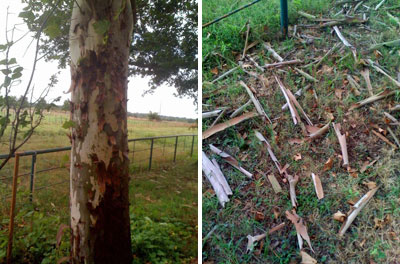
Answer: You have no problem at all. This seems to be a sycamore. It, like crape myrtles and other trees, shed their bark in long sheets. You’re seeing the next round of bark forming below. No problem. This is absolutely normal.
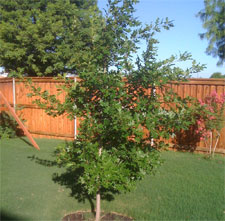
Question: Does my young red oak (growing beautifully) need to be pruned to remove some of its lower branches? K.C., Keller.
Answer: Yes. There is about a foot’s worth (my guess, not a precise measurement) of branches that can come off now. You could also wait for mid-winter to do so, when the tree is bare and when you can see the branching better. Do not go higher than 40 percent of the total tree’s height as you remove branches, however. If in doubt, wait. You can always remove them later. You can’t stick them back on.
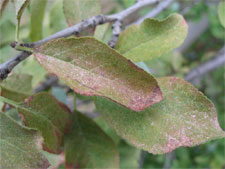
Question: The leaves on our 8-year-old Damson plum bushes are yellowing, dull in color and are covered with a powdery coating that does not rub off. Many of the plums have large, brown scars. We were told it was spider mite damage. We wanted your opinion. J. and A.N., no city given.
Answer: It’s unusual for spider mites to invade fruit trees, but it does seem that they are involved. The discoloration and the debris left on the leaves look like what spider mites would do. Try thumping one of the twigs over white paper. If you see nearly microscopic specks starting to walk, those are the mites. Malathion will help with them, and it’s labeled for use on fruit crops. Perhaps other readers who have experienced similar issues will chime in.
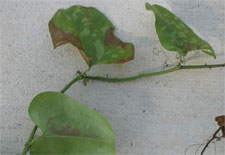
Question: In order to kill this weed, I need to identify it first. I’ve taken it to several nurseries and their answers range from "I don’t know" to "It’s in the poison ivy family." How do I get rid of it? G.O’L., Boerne.
Answer: This is smilax briar, and here is the information I have in the Most Asked Question section of my website. (It is not related at all to poison ivy.)
Question: We have an 8-year-old bald cypress tree that has turned yellow this spring. At first, I thought it was spider mites or bagworms, but I now see that the bark is gone on all sides of the tree, three-fourths of the way up the trunk. Is there an insect that eats just bark? I don’t think it was lightning, since it’s only the bark that is falling. What would cause this? G.L, Aledo.

Answer: Lightning was what crossed my mind before I saw all of your note. The setting looks like a place where that could happen (tree is tallest thing in an open space). This is not unlike the way lightning hits trees, blowing bark off their trunks. You should be able to see teeth marks in part of the tissues if rodents peeled the bark off. My vote is to sit tight and see what evolves. There’s nothing you can do at this point.

